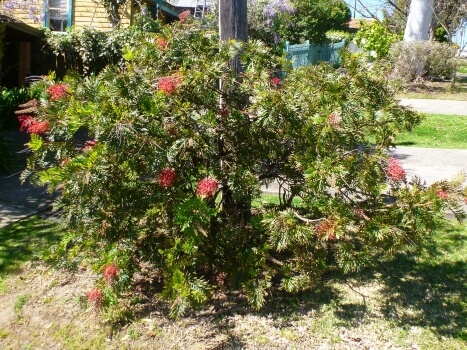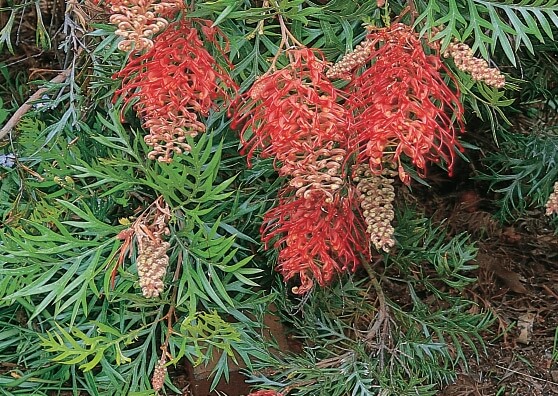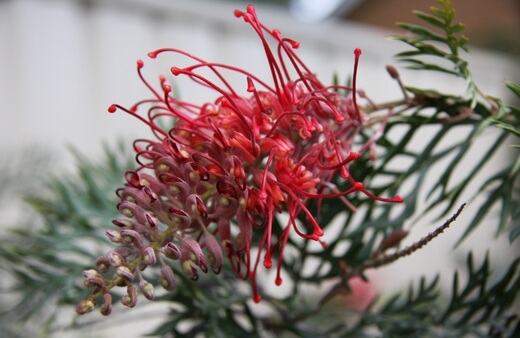Grevillea ‘Robyn Gordon’ is one of the most commonly grown hedging plants in Australia, with gorgeous crimson red flowers that can last right through from spring to winter. If you want to brighten up your boundaries then stick with us through this simple guide to growing Grevillea ‘Robyn Gordon’.
I’ve compiled a beginner’s guide to growing this beautiful shrub. Follow it through for flawless flowering Grevillea ‘Robyn Gordon’ every time.
More...

Family: | Proteaceae |
|---|---|
Genus: | Grevillea |
Species: | Cross: G. banksii x G. bipinnatifida |
Cultivar: | ‘Robyn Gordon’ |
Common name: | Grevillea ‘Robyn Gordon’ |
Location: | Outdoor |
Type: | Evergreen shrub |
Growth: | 2m x 2m |
Sun requirements: | Full sun to part shade |
Foliage Colour: | Green |
Flower Colour: | Crimson red |
Flowering: | All year |
Fruit: | Not edible |
Maintenance level: | Low |
Poisonous for pets: | Toxic to cats and dogs (rashes, itching, and stomach upset) |
What is Grevillea ‘Robyn Gordon’?
Grevillea ‘Robyn Gordon’ is a specially bred garden cultivar, crossed between Grevillea banksii and Grevillea bipinnatifida, two native Grevillea species with slightly different flowering habits.
The result is a year-round flowering cultivar, which brightens up gardens with fireworks of flowers when the weather outside feels like anything but summer. Most commonly grown as a hedging plant, Grevillea ‘Robyn Gordon’ is easy to grow, simple to plant, and has a completely fool-proof care routine.
Natural Habitat of Grevillea ‘Robyn Gordon’
Grevillea ‘Robyn Gordon’ is not a naturally occurring species, but its parents, G. banksii and G. bipinnatifida, are native to Queensland and grow best in warm, bright locations in full sun.
However, Grevillea ‘Robyn Gordon’ can be grown with great success in partial shade in slightly cooler climates.
How to Grow Grevillea ‘Robyn Gordon’

Source: gardeningwithangus.com.au
What’s truly magnificent about Grevillea ‘Robyn Gordon’ is that it will grow in virtually any condition, provided it has reasonable drainage and doesn’t freeze. Having said that, it’s still worth trying to get the conditions just right, as proper soil preparation and watering will lead to more vigorous and reliable flowering from longer in the year.
Best Soil for Grevillea ‘Robyn Gordon’
Any well-drained soil is perfect for grevillea, but where possible, slightly acidic soils are better, and if you have the opportunity it is well worth testing your soil nutrients as phosphorus can trigger a single flush of flowering.
Try to avoid phosphorus where possible, or use minimal amounts if you do decide to use a liquid feed around the roots. Focus on nitrogen and potassium-based soil improvers to get the soil conditions just right for long-flowering Grevilleas.
Light Preference
Grevillea ‘Robyn Gordon’ needs bright conditions but can cope with part shade. Growing it beneath the canopy of a tree won’t do it any harm, but growing it against the south wall of a house will put significant strain on your plants. The results of full shade will be leggy plants with little to no flowering.
Watering Needs
When you first plant Grevillea ‘Robyn Gordon’, it’s important to water each plant generously. Once it has started to show signs of new growth, just leave it to the elements, and water only when it looks bone dry around the roots.
They are well adapted to dry climates and hot weather so can cope with surprisingly little water once they reach maturity.
How to Plant Grevillea ‘Robyn Gordon’
Plant Grevillea ‘Robyn Gordon’ in a hole that is twice the size of its pot, 1-2cm proud of the soil surface to prevent it from sitting in a puddle after heavy rains for its first year.


Get Your Free Guide:
Master Growing Australian Natives eBook
A Must Have Complete Guide for Every Australian Garden
Get Your Free Guide:
Master Growing Australian Natives eBook
A Must Have Complete Guide for Every Australian Garden
Prepare the planting hole by digging out the base with a fork. That way, as the plant is established and is watered in over its first summer, it will slowly settle to the same level as the soil, without ever risking damp rot.
For full effect, plant Grevillea ‘Robyn Gordon’ in rows to create dramatic hedges. Plant each Grevillea 1m apart to allow them space to grow. On windy sites, providing loose stakes for the first two years will prevent excessive rocking.
How to Propagate Grevillea ‘Robyn Gordon’
There are two easy ways to propagate Grevillea ‘Robyn Gordon’, but growing these plants from seed does take quite a lot of patience!

Source: plantnative.com.au
Propagating Grevillea ‘Robyn Gordon’ from Seed
Growing Grevillea ‘Robyn Gordon’ from seed can take up to three years for germination. You can speed things up by vernalizing your seeds on and off though. Essentially, the cooling and heating of the seasons will crack the seeds, and maintain their moisture as they develop.
Cooling seeds in a fridge for one month, then warming them for a week, and repeating the process can trigger germination in the first year, but the easiest way is to plant seeds in the ground and just wait!
Grevillea ‘Robyn Gordon’ Propagation from Cuttings
Cuttings are the fastest way to create new Grevillea plants, and they are really simple to take. There’s plenty of advice online about taking semi-ripe or hardwood cuttings but I’ve always found greenwood cuttings to be most effective with all Grevillea varieties.
- In early summer, choose a healthy section of new growth that hasn’t yet formed any bark. Cut away 15-20cm of the shoot, and remove any lower leaves.
- Working quickly so the cutting doesn’t dry out, cut again just below the lowest node, and dip it into the rooting hormone.
- Place the cutting directly into a 50:50 mix of perlite and used compost.
- Water it until water runs out of the bottom of the pot.
- Leave in a cold frame, or cover with a clear plastic bag to retain moisture.
- Keep cuttings away from direct sunlight until new growth starts (this can be late summer, or early next spring, so be patient).
- Plant into fresh compost when new foliage starts to develop.
Grevillea ‘Robyn Gordon’ Care Guide
Mature Grevillea ‘Robyn Gordon’ benefits hugely from an annual mulch to boost their soil nutrients in spring, which can help them to continue flowering right through the year. However, there are some specifics that are worth keeping in mind.

Source: cwdesignlandscaping.com
Mulching Grevillea ‘Robyn Gordon’
Only ever mulch Grevillea ‘Robyn Gordon’ in spring, never in autumn or winter, as they will hate being damp and winter mulches lock in too much moisture in the soil.
Use wood chip mulches or leaf mould, which will boost nitrogen as they decompose into the soil, without affecting phosphorus levels too high.
What Fertiliser to Use
Any native plant fertiliser will support healthy growth for Grevillea ‘Robyn Gordon’. Feed once in early spring, and repeat the process in summer. To keep the plant on its natural cycles avoid feeding your shrubs in autumn and winter.
Pruning Grevillea ‘Robyn Gordon’
While established grevilleas can be pruned like a hedge, it’s important to build a structure first. Like any hedging plant, or low growing shrub, it might be tempting to let it grow up tall as quickly as possible, but what you’ll end up with is lots of long, weak shoots that have very little support.
After planting a young Grevillea ‘Robyn Gordon’, cut it back by about 1/3 in spring. This will encourage new growth, and each branch should split into two, creating a denser internal structure, which will eventually be covered in foliage and flower.
Grevillea ‘Robyn Gordon’ Problems, Pests and Diseases
Grevillea rarely suffers from problems when grown outdoors in Australia, but a sure sign of bad planting is the presence of insects and fungal problems, which are almost always caused by damp conditions.
Scale and Leaf borers
We’ve got a run-through of the most common pests and diseases below, but the best way to fix all of them is to improve drainage. There are two super common pests on Grevillea ‘Robyn Gordon’; scale and leaf borers.
Both are signs of damp conditions, feeding on the excess moisture in the leaves. Both will also cause fungal infections in the plant if left unchecked.
Scale insects are brown insects with a creamy-coloured secretion covering their soft shells to deter predators. Leaf borers are harder to spot, but you’ll probably notice brown or yellow rings around damaged sections of leaf.
Improving drainage will reduce the problem, but you can quickly get rid of both by spraying the plant with an organic insecticide like neem oil.
Diseases are very uncommon in Grevillea ‘Robyn Gordon’, but as a garden-specific cultivar, poor placement or damp conditions can lead to some common fungal problems.
Fungal infection
Fungal infections lead to wilted and discoloured leaves, which will start to fall from the plant, and can spread down shoots, causing brown or black mushy stems. Remove any discoloured parts of the plant when you see them to prevent spread and improve drainage to reduce further problems.
Root rot, particularly fungal root rot, is harder to deal with, but there are soil treatments available for fungal infections in plant roots that can help to clear up early signs of infection.
Black sooty mould
Black sooty mould is caused by scale insects and spreads from plant to plant. It looks exactly like it sounds, and develops around the base of leaves and along young shoots, causing flowers to fail and leaves to fall from the grevillea.
As leaves drop, they can leave spores on other parts of the plant. Remove them when you see them and burn them where appropriate to stop the spread.
Grevillea ‘Robyn Gordon’ Frequently Asked Questions

What is the best fertiliser for Grevillea ‘Robyn Gordon’?
Any low-phosphorus fertiliser is ideal for Grevillea ‘Robyn Gordon’. Phosphorus triggers a flush of flowers, leading to a largely foliage focussed plant for the rest of the year.
Try to avoid this, and focus on nitrogen and potassium to evenly develop plant growth right through the year. Native plant fertilisers, or fertilisers with a 10-2-10 or 15-0-15 NPK are ideal.
How big does Grevillea ‘Robyn Gordon’ grow?
Grevillea ‘Robyn Gordon’ grows to about 2m tall by 2m wide after ten years without pruning but looks best when pruned to about 1.5m tall. Growing each shrub at 1m apart will help to naturally limit their width.
How long do Grevillea ‘Robyn Gordon’ flowers last when picked?
Grevillea ‘Robyn Gordon’ blooms can last from up to a week in a vase but will need a pinch of sugar added to the water to help them extend beyond their first three days. Blooms on the plant will last for around 1-2 weeks before they drop.
Wrapping Up Our Grevillea ‘Robyn Gordon’ Growing and Care Guide
There aren’t many hedging plants more dramatic than Grevillea ‘Robyn Gordon’, so if you’re looking for native beauty with a bit of a twist, try this garden-friendly cultivar, which is easy to prune, simple to feed, and indulgent to look at.
Understanding how to grow Grevillea ‘Robyn Gordon’ is important to get you started, but once your hedge has established, there’s very little ongoing care, other than an annual prune.
Published on November 3, 2022 by Nathan Schwartz
Last Updated on February 22, 2024





I just read your article about Grevillea Robyn Gordon. I am in desperate need of more specific information about how to prune these plants. I have 4 of them that have been in the ground four about four years. (I live in the San Francisco Bay Area.)
The plants are healthy and growing well. However, the branches grow very long and want to droop. I have staked them as well as I can to keep them more upright, but I think they might be better behaved if I could prune them properly.
Your article says to prune them back to 1.5 meters. If they weren't staked on trellises they probably wouldn't be more than about that height. They don't grow tall as much as the branches just get long and hang down. Are there any good visual sources that would show me how to prune these plants properly? Thank you very much.
Hi Laurie,
They tend to form into a hedge that looks at it best at 1.5m tall, but like any hedging plant, it should be pruned by about a third each year while it’s starting out (if the intention is to grow it as a hedge). Any woody shrub cut back regularly while its shape develops a more rigid structure and will rely less on individual long branches once it’s developed.
Obviously, it’s tempting to let plants like grevillea grow up quickly by leaving stems to develop but the results will always be branches that are too heavy for themselves.
What I’d suggest for now, is to cut every other branch back hard, to about 2ft off the ground, or wherever the lowest bud is. Then repeat with the alternate branches next year. That way you’ll get to keep your flowers and structure for now, and in a few years should have a decent shrub. But make sure to cut it back regularly to encourage more branching as it develops.
Best regards,
Nathan Schwartz